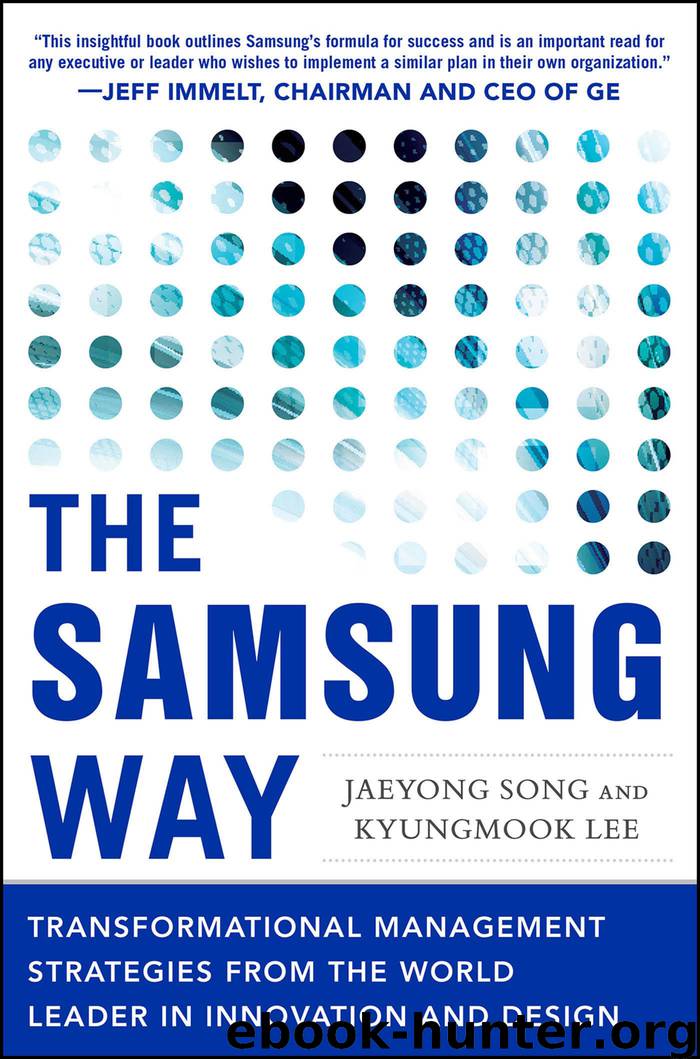The Samsung Way by Jaeyong Song

Author:Jaeyong Song
Language: eng
Format: epub
Publisher: McGraw-Hill Education
Published: 2014-08-22T16:00:00+00:00
Vertical Integration
Vertical integration, where internal business units or affiliates manufacture critical parts and materials, is another major factor that has contributed to Samsung’s ability to create speed. An integrated local supply chain eliminates barriers like language, business culture, and way of thinking that arise when a company uses external suppliers. Thus, communication problems are minimized, resulting in time savings.
To prevent conflicts of interest, there is a strong wall between Samsung’s consumer products division and its components division, ensuring that customer information is secure and confidential. Samsung’s semiconductor division, for example, supplies its products not only to Samsung Electronics’ mobile division, but also to competitors like Apple and Nokia. If confidential information from Samsung’s semiconductor division were leaked to its mobile division, Apple and Nokia would end their relationship with the semiconductor division.
Accordingly, Samsung’s parts divisions, including semiconductors, stress equal treatment of in-house users and external clients, ensuring that confidential information about parts customers is never leaked. Nonetheless, Samsung’s common language and culture and the units’ geographical proximity allow smoother communications and feedback between the divisions than with external clients.
By the mid-2000s, Japanese companies needed 10 months on average to plan and release camera-equipped mobile phones. Samsung, in contrast, could complete the process in only 5 months through interaffiliate collaboration, an approach that continues today. Samsung’s pursuit of leadership in the TV industry also benefited from the clustering of Samsung Advanced Institute of Technology, the DMC R&D Center, the System LSI division, and the Visual Display division. By collaborating, these organizations completed the development of A1, a core system-on-chip (SoC) technology for digital TV, in 14 months, allowing Samsung to commence mass production of TVs only 6 months later. By assembling all of the company’s know-how and expertise in a single place and making decisions quickly, Samsung was able to slash the time from development to commercialization from 36 months to 20 months.
Likewise, clustering led to strong returns in Samsung’s display panel business. Samsung’s LCD plant in Cheonan sharply reduced time and production costs by transporting unpackaged glass from Samsung Corning Precision Materials,16 which is located near its production lines, through underground air tables. Collaboration with the system semiconductor division in developing display driver integrated circuits helped cut development time in half compared to rivals.
Download
This site does not store any files on its server. We only index and link to content provided by other sites. Please contact the content providers to delete copyright contents if any and email us, we'll remove relevant links or contents immediately.
Hit Refresh by Satya Nadella(9038)
The Compound Effect by Darren Hardy(8808)
Change Your Questions, Change Your Life by Marilee Adams(7635)
Nudge - Improving Decisions about Health, Wealth, and Happiness by Thaler Sunstein(7615)
The Black Swan by Nassim Nicholas Taleb(7010)
Deep Work by Cal Newport(6879)
Daring Greatly by Brene Brown(6445)
Rich Dad Poor Dad by Robert T. Kiyosaki(6401)
Principles: Life and Work by Ray Dalio(6209)
Man-made Catastrophes and Risk Information Concealment by Dmitry Chernov & Didier Sornette(5921)
Playing to Win_ How Strategy Really Works by A.G. Lafley & Roger L. Martin(5917)
Digital Minimalism by Cal Newport;(5664)
Big Magic: Creative Living Beyond Fear by Elizabeth Gilbert(5610)
The Myth of the Strong Leader by Archie Brown(5425)
The Slight Edge by Jeff Olson(5346)
Discipline Equals Freedom by Jocko Willink(5285)
The Motivation Myth by Jeff Haden(5156)
Stone's Rules by Roger Stone(5026)
The Laws of Human Nature by Robert Greene(4998)
